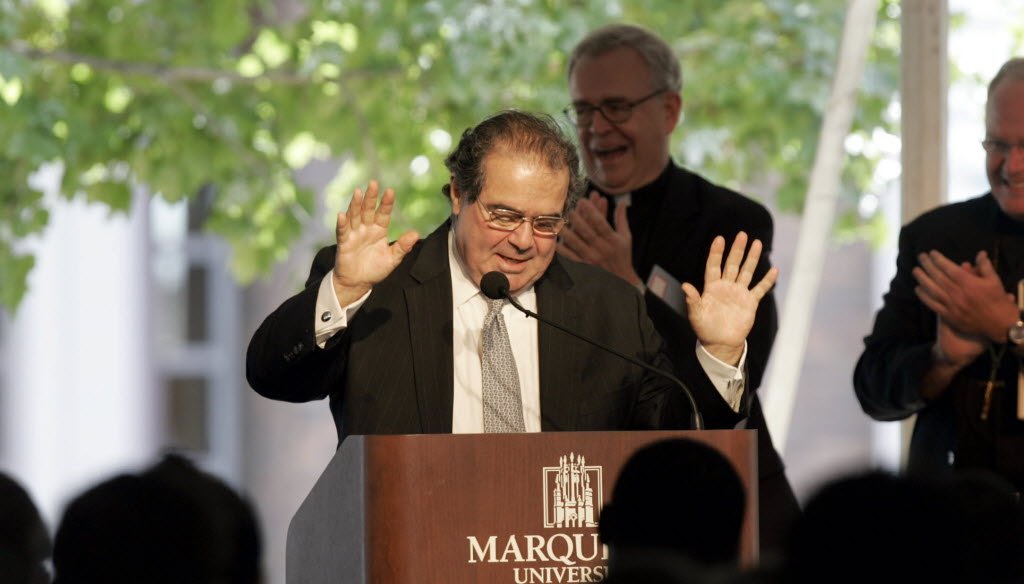

Our only agenda is to publish the truth so you can be an informed participant in democracy.
We need your help.


The late U.S. Supreme Court Justice Antonin Scalia spoke at the dedication of Eckstein Hall at Marquette University Law School in Milwaukee on Sept. 8, 2010. His death created a debate in the 2016 presidential campaign. (Milwaukee Journal Sentinel photo)
Ten days after the death of U.S. Supreme Court Justice Antonin Scalia, House Speaker Paul Ryan entered the debate on whether Scalia’s successor should be chosen before or after Barack Obama leaves the Oval Office.
The Democratic president has the right to submit a nominee before he departs in January 2017, said the Wisconsin Republican, appearing Feb. 23, 2016 on CNBC’s "Squawk Box."
But the GOP-controlled Senate, Ryan added, has the right not to move the nomination forward and instead await a nomination from the next president.
Then co-host Andrew Ross Sorkin asked: "Should you look at whoever gets nominated on the merits of who they are, or simply on the politics of the moment?"
"We are in the politics of the moment, which is we are in the middle of a presidential election," Ryan said, referring to the early 2016 primaries and caucuses. "We’ve already had South Carolina, New Hampshire and Iowa. We’re knee-deep in a presidential election.
"There’s a reason for having this tradition of not nominating somebody in the middle of a presidential election, because it gets so political. I agree with that precedent, and there is a precedent for that."
It’s relatively rare for a Supreme Court vacancy to occur in the months leading up to a presidential election.
But Ryan’s office could not provide any examples in which a president did not make a nomination during a presidential election year.
We couldn’t find any, either -- though, to the contrary, we did find a number of instances in which such a nomination was made.
The record
Let’s note that when it comes to filling Supreme Court vacancies, presidents decide when to nominate, and the Senate decides when to consider the nomination. Often, the administration gets a read on where the Senate stands on confirming a nominee before putting someone forward. But formally, the timing for the first step is up to the president.
We found five instances over roughly the past century in which there was a Supreme Court vacancy in a presidential election year and the president made a nomination.
President
Nominee
Nomination
Outcome
Franklin Roosevelt (D)
Frank Murphy, to replace Pierce Butler
January 1940
Confirmed
Herbert Hoover (R)
Benjamin Cardozo, to replace Oliver Wendell Holmes
February 1932
Confirmed
Woodrow Wilson (D)
Louis Brandeis, to replace Joseph Rucker Lamar
January 1916
Confirmed
Woodrow Wilson (D)
John Clarke, to replace Charles Evans Hughes
July 1916
Confirmed
William Taft
Mahlon Pitney, to replace John Marshall Harlan
February 1912
Confirmed
Johnson nominated Abe Fortas, who was a sitting justice, to succeed Earl Warren as chief justice, after Warren indicated he wanted to retire. Fortas hit strong opposition in the Senate Judiciary Committee and in the face of a filibuster, he asked that his name be withdrawn. (The hearings uncovered questionable speaking fees Fortas received, and he resigned from the court in 1969.)
Johnson had also nominated Homer Thornberry to take Fortas’ place on the court. But that nomination, too, was withdrawn, since Fortas was never elevated.
In October 1956, Republican President Dwight Eisenhower did something even more extraordinary than making a nomination less than a month before election day. He put William Brennan directly on the court with a "recess appointment" to replace Sherman Minton. He then formally nominated Brennan in January 1957.
A February 2016 article in the Cook Political Report by University of Georgia political scientist John Anthony Maltese notes there were also presidential election-year nominations made to the Supreme Court in the 1800s.
Our rating
Ryan said: "There is a precedent" for not nominating someone to the U.S. Supreme Court "in the middle of a presidential election.’
It’s rare for a Supreme Court vacancy to occur during a presidential election year -- the last time was in 1940, although there were also two election-year nominations in 1968.
But we could find no instances in which a president faced with a Supreme Court vacancy during a presidential election year did not make a nomination. It occurred five times between 1912 and 1940, and each time the nominee was confirmed.
We rate Ryan’s statement False.
CNBC, video of Paul Ryan interview (1:45), Feb. 23, 2016
Email, Paul Ryan press secretary Ian Martorana, Feb. 29, 2016
Email, Wisconsin Democratic Party communications director Brandon Weathersby, Feb. 29, 2016
PolitiFact National, "Ted Cruz overstates Supreme Court nomination ‘tradition,’" Feb. 14, 2016
PolitiFact Florida, "Rubio exaggerates in saying it’s been 80 years since a ‘lame duck’ made a Supreme Court nomination," Feb. 14, 2016
PolitiFact National, "Do presidents stop nominating judges in final year? (False)," Feb. 14, 2016
New York Times, "Election-year Supreme Court nominations are rare," Feb. 13, 2016
Email, Brookings Institution visiting fellow Russell Wheeler, Feb. 26, 2016
Interview, Lisa Holmes, University of Vermont professor of political science, Feb. 26, 2016
SCOTUSblog, "Supreme Court vacancies in presidential election years," Feb. 13, 2016
Interview, Sarah Binder, professor of political science at George Washington University, Feb. 26, 2016
FactCheck.org, "Cruz, Rubio twist court ‘precedent,’" Feb. 17, 2016
Cook Political Report, "The long history of presidents nominating Supreme Court justices in presidential election years," Feb. 15, 2016
In a world of wild talk and fake news, help us stand up for the facts.
